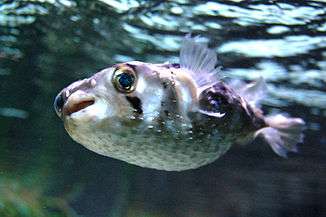Diodon
This article is about the fish. For the clipboard software, see Diodon (software).
| Porcupinefishes Temporal range: 55–0 Ma | |
|---|---|
 | |
| Diodon holocanthus | |
| Scientific classification | |
| Kingdom: | Animalia |
| Phylum: | Chordata |
| Class: | Actinopterygii |
| Order: | Tetraodontiformes |
| Family: | Diodontidae |
| Genus: | Diodon Linnaeus, 1758 |
Porcupinefishes or balloonfishes, are any of the various species of the genus Diodon, the type genus of Diodontidae.
Distinguishing features
Fish of the genus Diodon have:
- two-rooted, movable spines (which are derived from modified scales) distributed over their bodies.
- beak-like jaws, used to crush their hard-shelled prey (crustaceans and molluscs).[2]
They differ from the swelltoads and burrfishes (genera Cyclichthys and Chilomycterus, respectively), which, in contrast, have fixed, rigid spines.
Defense mechanisms
- Like true pufferfishes of the related family Tetraodontidae, porcupinefishes can inflate themselves. Once inflated, a porcupinefish's erected spines stand perpendicular to the skin, whereupon they then pose a major difficulty to their predators: a large porcupinefish that is fully inflated can choke a shark to death. According to Charles Darwin in The Voyage Of the Beagle (1845), Darwin was told by a Doctor Allen of Forres, UK that the Diodon actually had been found "floating alive and distended, in the stomach of the shark" and had been known to chew its way out of shark bodies after being swallowed, causing the death of its attacker.[3]
- They may be poisonous, through the accumulation of tetrodotoxin or ciguatera.[2]
Species
Fossil dental plate of Diodon. Miocene of United States
Fossil
Fossils of porcupinefishes are known from Tertiary-aged marine strata. These species are similar to modern species. Fossil species include:
- Diodon tenuispinus, from the Ypresian-aged Monte Bolca lagerstatte.
- Diodon scyllai, from middle Miocene-aged Piemonte, Italy.
Extant
There are currently five recognized extant species in this genus:[4]
- Diodon eydouxii Brisout de Barneville, 1846 (Pelagic porcupinefish)
- Diodon holocanthus Linnaeus, 1758 (Long-spined porcupinefish)
- Diodon hystrix Linnaeus, 1758 (Spot-fin porcupinefish)
- Diodon liturosus G. Shaw, 1804 (Black-blotched porcupinefish)
- Diodon nicthemerus G. Cuvier, 1818 (Slender-spined porcupinefish)
-

Diodon holocanthus puffed up and taken out of the water.
References
- ↑ Sepkoski, J. (2002). "A compendium of fossil marine animal genera". Bulletins of American Paleontology. 364: 560.
- 1 2 Lieske, E. & Myers, R.F. (2004): Coral reef guide; Red Sea London, HarperCollins ISBN 0-00-715986-2
- ↑ Darwin, C. (1845). Journal of researches into the natural history and geology of the countries visited during the voyage of H.M.S. Beagle round the world, under the Command of Capt. Fitz Roy, R.N. 2d edition. London: John Murray. p. 14.
- ↑ Matsuura, K (2014). "Taxonomy and systematics of tetraodontiform fishes: a review focusing primarily on progress in the period from 1980 to 2014". Ichthyological Research. 62 (1): 72–113. doi:10.1007/s10228-014-0444-5.
This article is issued from Wikipedia - version of the 10/26/2016. The text is available under the Creative Commons Attribution/Share Alike but additional terms may apply for the media files.



